Having solved the problem of housing shortages in the early years, the focus of the public housing programme shifted to enhancing the lifestyle of residents through comprehensive town planning. Our towns are planned to be self-sufficient and various upgrading programmes are implemented regularly to constantly improve the living environment. Toa Payoh is one of the earliest towns planned with comprehensive town planning principles and serves as a model for future towns.
Along with the evolution of our housing landscape, our city centre also began its dramatic rise from being a district filled with slums to a metropolitan financial nerve centre that is plugged into the global economy.
Comprehensive Towns, Vibrant Communities
Toa Payoh : A Town of Many Firsts
Toa Payoh was the first town that was designed and developed solely by HDB with comprehensive town planning principles. It serves as a model for the development of future residential towns in Singapore.
Toa Payoh also served as a pilot for many ideas and designs that were later adapted across other towns such as Ang Mo Kio, Bedok and Clementi.
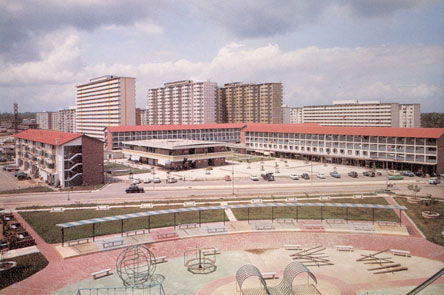
Layout
Toa Payoh was designed to be split into four neighbourhoods clustered around a town centre. Each neighbourhood would have its own shops and community centre, while the town centre would have larger stores and facilities.
One of a Kind
The unique Y-shaped block 53 offered a panoramic view of the Toa Payoh estate from its 19th floor viewing deck.
Also known as the VIP block, it played host to many foreign dignitaries who wished to view Singapore’s public housing feats, most notably Queen Elizabeth II of Britain in 1972.
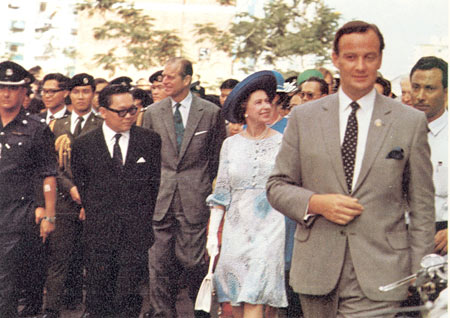
Games Village
In 1973, Singapore hosted the 7th South-East Asian Peninsular (SEAP) Games. The newly completed Toa Payoh town was ideal as the Games Village.
The town housed the Games' participants as well as the Games’ secretariat.
Toa Payoh Swimming Complex, which has an Olympic sized pool as well as a diving pool, also featured in the 12th and 17th South-East Asian (SEA) Games where it served as the location for the indoor water sports events. The swimming complex was utilised once again to host the diving events for the first ever Youth Olympic Games in Singapore in 2010.
Changing With The Times
Even though Toa Payoh is one of the oldest estates, it has been rejuvenated through various estate renewal programmes.
Greening of Toa Payoh
Think of Singapore, and one conjures up an image of beautiful and majestic trees lining most expressways. Efforts have been made to blend and harmonise nature with urbanisation – and Toa Payoh is no different.
Landscaped areas and parks are distinctive features of Toa Payoh.
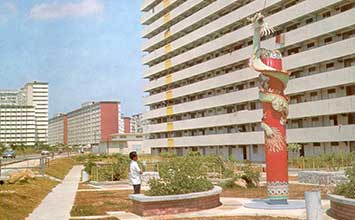
1960s
Humble Beginnings
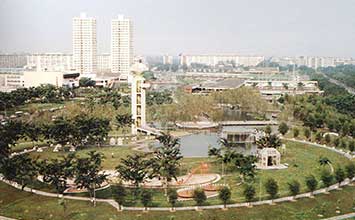
1970s
Toa Payoh Park

1980s
Estate Greenery
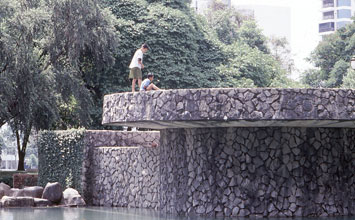
1990s
More than just plants
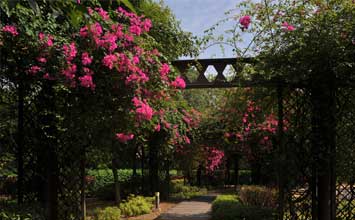
2000s
More colourful plants
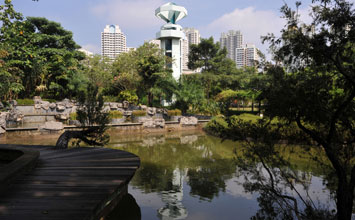
2010s
Enhanced Landscaping
Town Planning
Live, Work, and Play Near Home
Proper town planning means that amenities and landmarks are close to residents’ homes. Such facilities include:
- Libraries
- Hawker Centres
- Schools
- Offices
- Sport Complexes
- Playgrounds
DNA of Our Towns
Optimal Land Usage
Comprehensive town planning allows for efficient use of Singapore’s limited land space through optimal distribution of public amenities.
In the past, the “Checkerboard” pattern was used in town planning to ensure staggered variations in high and low densities, staggered heights of developments and the accessibility of community facilities.
Self-sufficiency
Various facilities are planned near homes in order to meet the different needs of residents, reducing the need for them to travel far out of their towns.
Structured Design
Smaller shops are located within the neighbourhoods, whereas town centres will contain larger facilities such as libraries and supermarkets.
Vibrancy
The design and structure of buildings within a town contributes to its unique identity and personality.
Intimate
Towns are further parcelled up into smaller neighbourhoods with facilities that serve as common social spaces for residents.
Evolving
As times and conditions change, planning and design methods constantly adapt to cater to the changing needs and wants of residents.
Estate Renewal Strategy
A New Lease of Life
Measures have been taken to ensure that the quality of older housing estates does not lag behind newer estates in vibrancy of the community or the provision of facilities.
Lift Upgrading Programme (LUP)
The Lift Upgrading Programme (LUP) was introduced in 2001 to offer direct lift services to flats, where feasible. Besides providing speedier and more convenient access to homes, the lifts also benefit the elderly, families with young children, and the less mobile. The scope of works include the upgrading of existing lifts, providing a lift landing on every floor and adding of new lifts and lift shafts.
Home Improvement Programme (HIP)
The Home Improvement Programme (HIP) replaced the Main Upgrading Programme (MUP) in 2007. It focuses on the interior of the flats, as compared to the MUP which provided enhancements to both flats and common areas.
HIP has two components, the ‘essential improvements’ component and the ‘optional improvements’ component. The ‘essential improvements’ component addresses common maintenance problems experienced by ageing flats, such as spalling concrete and ceiling leaks, while the ‘optional improvements’ component allows residents to upgrade their toilets and replace their main door.
Neighbourhood Renewal Programme (NRP)
The Neighbourhood Renewal Programme (NRP) focuses on precinct- and block-level improvements and is carried out on a larger scale (compared to Interim Upgrading Programme (IUP) Plus), across 2 or more contiguous precincts. The NRP integrates work across neighbourhood precincts, allowing resources to be pooled and a wider range of facilities to be provided. Common areas in HDB towns are enhanced with the provision of covered linkways, drop-off porches, playgrounds and fitness corners.
The key feature of the NRP is the programme’s active engagement of residents who collectively decide through dialogues and town hall forums on the improvements that they want to have in their neighbourhoods.
Selective En-bloc Redevelopment Scheme (SERS)
The Selective En-bloc Redevelopment Scheme (SERS) was launched in August 1995 �to enhance the living environment of older HDB estates. Under SERS, selected old blocks of home ownership flats with redevelopment potential are acquired under the Land Acquisition Act for redevelopment. The residents in these blocks are given an opportunity to move to new flats with fresh 99-year leases and a better living environment served by modern facilities.
Urban Planning
Land Use Planning
A Delicate Balancing Act
Our land use planning seeks to optimise Singapore’s land resources to cater to the current and future needs of our people.
We plan ahead for the needs of future generations while taking into account social, economic, and environmental considerations.
Concept Plan
The Concept Plan is a land use and transportation plan that guides Singapore’s development in the next 40 to 50 years.
Concept Plan 1971 (CP1971)

Singapore’s first Concept Plan focused mainly on basic infrastructure, including new towns, transport networks such as MRT lines, highways and parks.
CP1971 adopted a “Ring” Plan structure with a ring of high-density satellite towns around a central water catchment area.
Concept Plan 1991 (CP1991)
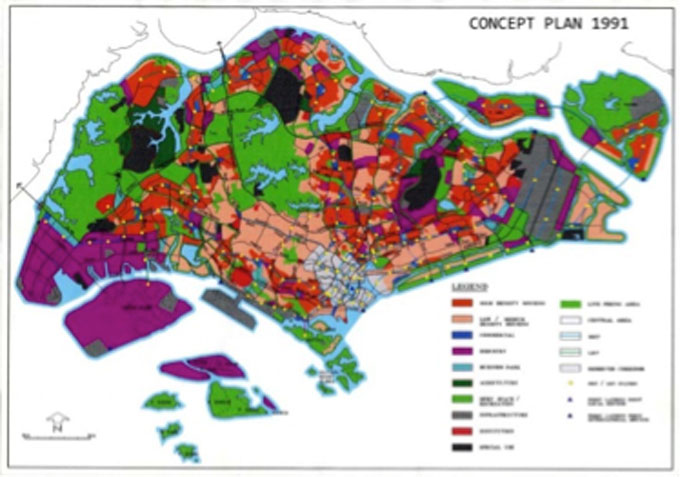
The vision was to create “an island city that balances work and play, culture and commerce”.
Decentralisation was first introduced to reduce congestion in the city state by creating regional, sub-regional, and fringe centres, bringing jobs closer to homes. Some of these centres today are located in Tampines, Novena, Jurong and Woodlands.
Concept Plan 2001 (CP 2001)
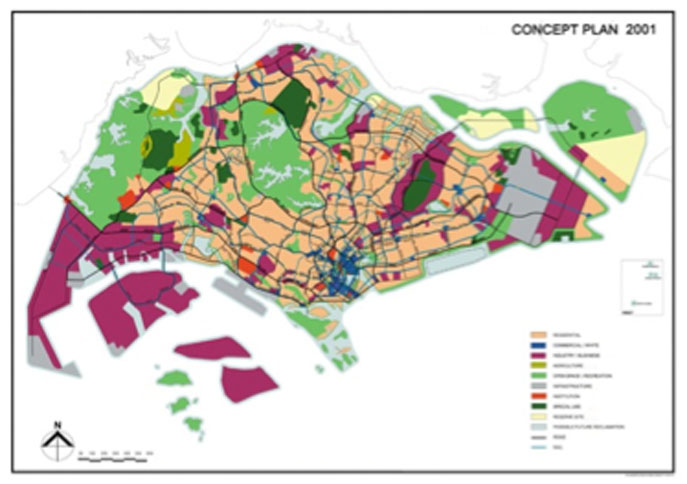
CP2001 aimed to provide high quality living environments with a wider variety of housing options.
It set aside land for financial and service sectors to support Singapore’s growth as a global financial hub.
The "Parks and Waterbodies Plan" and "Identity Plan" were introduced to make our green spaces more accessible, as well as retain and reinforce places with local identity and history. The Southern Ridges, a nine-kilometre stretch of rolling hills linked by two award-winning bridges, Henderson Waves and Alexandra Arch, were the result of the Identity Plan.
Concept Plan 2011 (CP2011) and MND's Land Use Plan

CP2011 review took into account public feedback gathered on building a sustainable population for Singapore. MND also released the Land Use Plan that outlines strategies to support population and economic growth, while continuing to ensure a high quality living environment by 2030. Land is set aside �to provide our future generations with growth and opportunities. Under CP2011, the North Coast Innovation Corridor is planned as an innovative economic corridor buzzing with ideas, creative design, and new technologies.
Master Plan
The Master Plan is a land use plan that translates the longer term strategies into detailed plans that guide Singapore’s development over the next 10 to 15 years. It is reviewed every five years and specifies the land use and density for each site.
Together, the Concept Plan and the Master Plan allow us to balance competing land use needs to create a quality living environment for our people.
Read More
Safeguarding Our Homes as Our Assets

To many, our HDB flats are not just a home. They are our valued assets, sometimes our largest single investment. To safeguard consumer interests and raise the professionalism of the real estate agency industry, the Council of Estate Agencies (CEA) was formed on 22 October 2010.
With CEA’s formation and the enactment of the Estate Agents Act, estate agents must now be licensed and real estate salespersons must be registered with the CEA to engage in real estate agency work.
As of 1 January 2015, consumers had a wide pool of more than 30,000 registered salespersons and over 1,300 licensed estate agents for choice.
In the past five years, CEA has implemented various regulations and initiatives to develop the real estate agency industry. As salespersons become more professional and have good knowledge of estate agency work, the number of consumer complaints has dropped by about 30%.
Useful tips
Some useful tips to remember when you engage a real estate salesperson!
Your salesperson will safeguard your interest in a property transaction:
- Offers you professional advice
- Represents you in negotiation, promptly updating you on offers and proposals
- Assists you to enter into a binding agreement and explains all relevant forms

- Seeks prior consent before advertising your property
- Declares any conflicts of interest and all external sources of income/referral fees to you
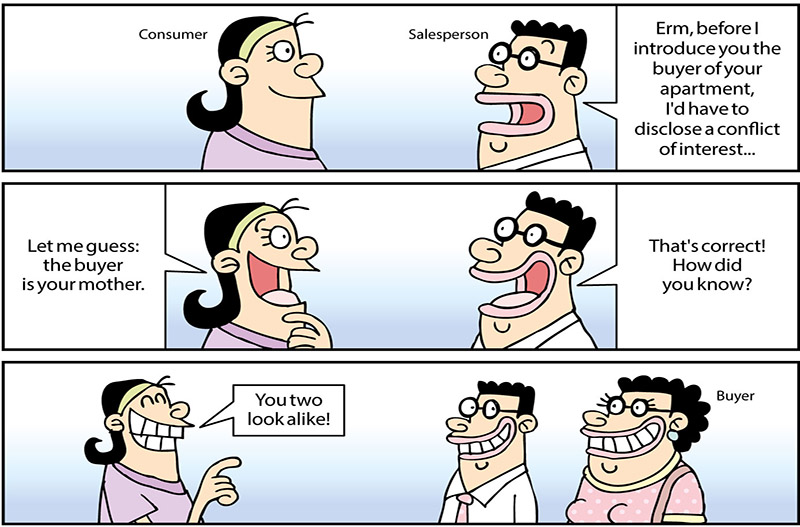
For HDB property transactions:
- Advises you on eligibility to buy, sell or lease
- Explains and goes through the Resale Checklist with you, checking whether renovations are authorised
- Assists you in submitting forms, documents and/or information required by HDB to process transaction
For a smooth property transaction, consumers need to do your part when engaging real estate salespersons:
- Check the CEA Public Register to confirm the identity of your salesperson

- Negotiate the commission payable
- Use the prescribed estate agency agreement
- Provide accurate information to your salesperson
- Understand all documents before signing
- Do not hand transaction monies to your salesperson
To download our consumer tips please go to the following links:
Visit CEA's website to find out more